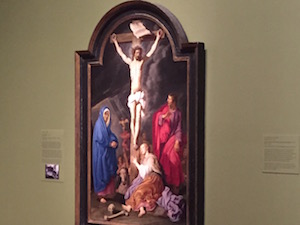 Today, we went to the VMFA to learn more about different types of artwork ranging from back in the renaissance to modern times. Douglas, who was our tour guide was extremely knowledgeable about the artworks around the museum. My PAL and I got to learn about how artworks have evolved from being very abstract and vibrant to a light and dark contrast. People were very interested in religious symbols back then and they painted a picture of Mother Mary wearing mostly blue, which back in the day the blue hue used was the most expensive out of all the hues, symbolizing that she was very important and rich. As we move along to different eras, the type of paintings moved away from being religious to being about nature and having a darker contrast. The frames containing the portraits also changed to being very simple instead of elegant and detailed. The last spot of our tour show paintings that are not even on a canvas anymore but artists have moved to painting on walls with very simple color such as red, yellow, blue, and green.
Today, we went to the VMFA to learn more about different types of artwork ranging from back in the renaissance to modern times. Douglas, who was our tour guide was extremely knowledgeable about the artworks around the museum. My PAL and I got to learn about how artworks have evolved from being very abstract and vibrant to a light and dark contrast. People were very interested in religious symbols back then and they painted a picture of Mother Mary wearing mostly blue, which back in the day the blue hue used was the most expensive out of all the hues, symbolizing that she was very important and rich. As we move along to different eras, the type of paintings moved away from being religious to being about nature and having a darker contrast. The frames containing the portraits also changed to being very simple instead of elegant and detailed. The last spot of our tour show paintings that are not even on a canvas anymore but artists have moved to painting on walls with very simple color such as red, yellow, blue, and green.
Linh Tu, graduate student in Pharmacy




